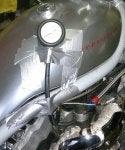What equipment are others using to measure fuel pressure? The only equipment I have is a guage that mounts in the fuel line between the pump and the fuel rail of a BMW and attaches to standard fuel hoses. The V-Rod uses a specific fitting, and it is not the same fitting used to attach the pressure guage to a Big Twin or Sportster.
Also, the Service Manual has you depressurizing the fuel injection line before unscrewing the cap on what is called the Schrader Valve. Rather than using the procedure in the manual it seems you could just as easily disconnect one of the lines to the fuel tank and accomplish the same thing.
Also, the Service Manual has you depressurizing the fuel injection line before unscrewing the cap on what is called the Schrader Valve. Rather than using the procedure in the manual it seems you could just as easily disconnect one of the lines to the fuel tank and accomplish the same thing.






